Kinshasa is the capital of the Democratic Republic of the Congo (DRC). Kinshasa is the DRC’s central economic, political, and cultural hub.

Kinshasa is famous for its vibrant music scene, particularly its contribution to the Afro-Pop genre known as Congolese Rumba or Soukous. It is characterized by its bustling street life and colorful markets.
Where is Kinshasa?
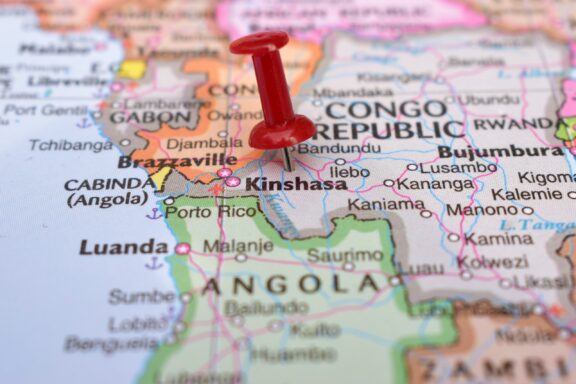
Kinshasa is located in the western part of the Democratic Republic of the Congo in Central Africa. It lies directly across the Congo River from Brazzaville, the capital of the Republic of the Congo, making them the two closest capital cities in the world.
The city is approximately centered at coordinates 4.4 °South latitude and 15.3 °East longitude. It is situated within the Congo Basin, the second-largest rainforest area after the Amazon.
Kinshasa’s location on the Congo River has made it a significant port and transportation hub. The river provides a vital network for transportation and trade, connecting different parts of the vast country.
History of Kinshasa
Kinshasa’s history is rich and complex, deeply intertwined with the broader history of the Democratic Republic of the Congo.
The area that is now Kinshasa was originally inhabited by Bantu groups, who settled in the region as early as the 7th century.
In the late 19th century, explorer Henry Morton Stanley arrived and established a post named Leopoldville in honor of King Leopold II of Belgium, marking the beginning of European influence in the area.
Leopold II ruled the region, known as the Congo Free State, as his private property, and it was a period marked by brutal exploitation and human rights abuses.
In 1908 due to international pressure, the Belgian state took over the Congo Free State, known as the Belgian Congo. Leopoldville continued to grow as an administrative and commercial center during this period.
The city gained its name, Kinshasa, after Congo gained independence from Belgium in 1960. Kinshasa became the capital of the newly independent nation and grew rapidly in size and importance.
In 1971, the country was renamed Zaire by then-president Mobutu Sese Seko, and it remained under his authoritarian rule for over three decades. During this time, with exquisite architecture and public works, Kinshasa symbolized Mobutu’s power.
In the 1990s, Kinshasa was a center of political unrest and violence as Mobutu’s regime faltered. Mobutu was ousted in 1997, and the country was renamed the Democratic Republic of the Congo.
Since then, Kinshasa has remained a city of contrasts, grappling with challenges such as poverty and infrastructure development while serving as the country’s economic, political, and cultural hub.
Features of Kinshasa
Kinshasa is an energetic, vibrant city pulsating with life. The city’s expansive borders house a wide array of contrasts and surprises that illustrate the complexities of this intriguing African metropolis.
Kinshasa is a city of contrasts and constant evolution. It’s a city where hardship, resilience, tradition, innovation, chaos, and creativity coexist, providing a captivating tableau of contemporary urban Africa.
Geography and Climate
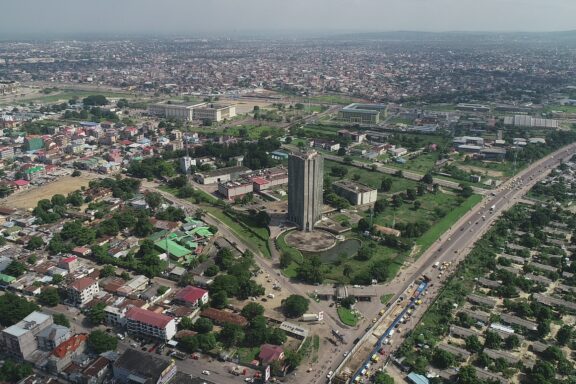
Kinshasa sprawls over a substantial area on the banks of the Congo River, one of the world’s deepest and second only to the Amazon in terms of volume. The city’s terrain includes flat and hilly areas, with many parts offering spectacular river views. The Congo River is dotted with islands and flanked by marshlands, influencing the city’s urban layout and land use.
The city’s climate falls under the tropical rainforest category, with a rainy and a dry season. Despite its proximity to the equator, the city’s temperatures are relatively moderate due to its elevation. The average temperature hovers around 25 degrees Celsius (77 degrees Fahrenheit). The rainy season generally spans from October to May, and the dry season occurs between June and September.
Population
Kinshasa is one of the most populated cities in Africa, with a population that has grown rapidly in the decades since independence. Today, it’s estimated to be over 17 million, though accurate counts are challenging due to the city’s expansive informal settlements.
Kinshasa’s population is diverse, reflecting the myriad ethnic groups that constitute the DRC. The city is a melting pot of cultures, languages, and traditions, with the Lingala and Kikongo languages being widely spoken alongside French, the official language.
Its residents, known as Kinois, are renowned for their resilience, creativity, and vibrant cultural expressions, especially in music and dance.
Economy
As the capital and the largest city of the DRC, Kinshasa serves as the country’s primary economic hub. The city has a diverse economy with crucial sectors, including services, trade, construction, and manufacturing.
Its location on the Congo River makes it a significant port and transportation hub, allowing for the import and export of goods, including mineral resources that are a crucial part of the national economy. Many of the DRC’s most prominent companies have their headquarters in the city, and it also hosts a substantial informal economy, particularly in its bustling markets.
However, Kinshasa’s economy also faces numerous challenges. These include infrastructure deficits, political instability, and social inequality. A significant proportion of the population lives in poverty and informality, illustrating the economic disparities within the city.
Despite these challenges, Kinshasa remains a vital economic engine for the DRC, with the potential for further growth and development.
Things to Do and Places to See in Kinshasa
Kinshasa presents a diverse array of activities and sights for exploration. Let’s explore some of this bustling capital city’s most frequented landmarks and attractions.
1. Lola ya Bonobo Sanctuary
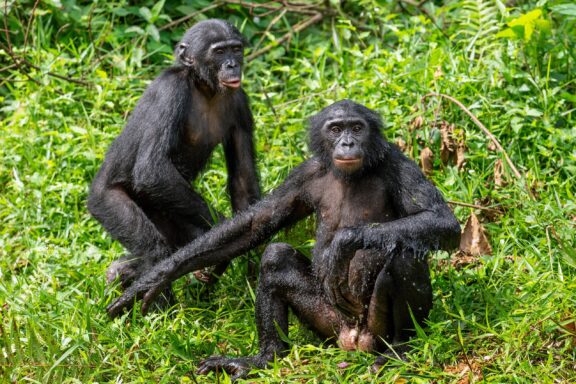
The Lola ya Bonobo Sanctuary is a unique haven dedicated to protecting and rehabilitating bonobos, a great ape endemic to the Congo Basin and is currently endangered. The sanctuary provides a unique opportunity for visitors to learn about these fascinating creatures and understand the crucial efforts being made to ensure their survival.
At Lola ya Bonobo, which translates to “Paradise for Bonobos,” these intelligent and sociable primates are cared for in an environment that closely resembles their natural habitat. Many of the bonobos here are orphaned and rescued from illegal wildlife trafficking. The sanctuary nurtures them back to health and, whenever possible, works towards their reintroduction into the wild.
2. Academy of Fine Arts
The Academy of Fine Arts is one of the most prestigious art institutions in the Democratic Republic of the Congo. Established in 1943 during the Belgian colonial period, it has a long history of nurturing artistic talent and contributing to the vibrant Congolese art scene.
The Academy is both an educational institution and a center for art. It offers training in various disciplines, including painting, sculpture, ceramics, graphic arts, and interior design. The institution is committed to promoting traditional Congolese art and contemporary artistic expressions, fostering a diverse and dynamic environment for creativity.
3. Kinshasa National Museum (Musée National de Kinshasa)
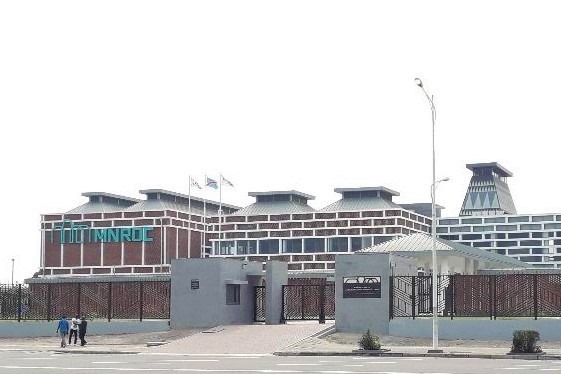
The Kinshasa National Museum, also known as Musée National de Kinshasa, is a treasure trove of Congolese culture and history. The museum houses a vast collection of artifacts that span a broad spectrum of Congolese history, from prehistoric times to the present day.
Visitors can view archaeological and ethnographic items, traditional art pieces, cultural artifacts, and more. These exhibits offer a deep dive into the diverse cultures that have shaped the Congo, including various Bantu ethnic groups, Pygmy communities, and the influence of colonial periods.
4. Parc de la Vallee de La Nsele
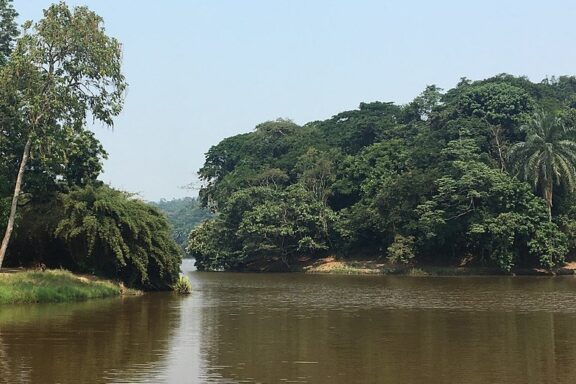
Ma Vallée is a tranquil natural retreat outside Kinshasa’s bustling center. This park, set in the beautiful Nsele River valley, offers visitors a break from the city’s hustle and bustle and a chance to immerse themselves in the region’s scenic natural beauty.
The park provides a range of outdoor activities for nature enthusiasts, including hiking trails that meander through lush vegetation, offering glimpses of local wildlife. It’s also home to a man-made lake where visitors can enjoy boating or relax by the water. For those interested in bird-watching, Ma Vallée hosts a variety of bird species.
5. Cathedral of Our Lady of the Congo
The Cathedral of Our Lady of the Congo, also known as Cathédrale Notre-Dame du Congo, is a significant landmark in Kinshasa. It is the city’s largest and most impressive religious building.
Completed in 1947, this Roman Catholic cathedral showcases architectural styles. It features a striking façade, and inside, the cathedral is spacious, with a high ceiling, stained glass windows, and religious artwork, all contributing to its serene and reverential atmosphere.
The Cathedral of Our Lady of the Congo is more than just a place of worship. It’s a vital part of Kinshasa’s community as a hub for various social and cultural activities. The cathedral has been the site of important national events, including state funerals and significant religious celebrations.
Frequently Asked Questions
What is the best time to visit Kinshasa?
The best time to visit Kinshasa is during the dry season, typically from June to September. During this time, the weather is more predictable and less likely to interfere with travel plans and outdoor activities.
Is it safe to visit Kinshasa?
Safety can vary in Kinshasa. As with any large city, it’s essential to stay alert, be aware of your surroundings, and take precautions to protect your personal belongings. Certain areas may be more prone to crime than others.
What is traditional food and cuisine like in Kinshasa?
Kinshasa’s cuisine combines traditional Congolese food and influences from other cultures. Staples include cassava, plantains, rice, and fufu (a dough-like dish made from cassava or other starches). Protein sources often include fish, goat, chicken, and beans.
What’s a must-try dish/food in Kinshasa?
You should try “moambe chicken,” a dish made with chicken, and palm nut cream, often served with rice or fufu. It’s considered the national dish of the DRC.
What souvenirs can I bring home from Kinshasa?
Popular souvenirs from Kinshasa include traditional Congolese art, wood carvings, textiles (like vibrant Congolese wax prints), and handmade jewelry. Be sure any items you purchase to bring home adhere to local and international regulations to protect cultural artifacts and endangered species.
Which currencies are accepted in Kinshasa?
The official currency of the DRC is the Congolese franc (CDF). While some businesses may accept U.S. dollars, having local currency on hand is generally a good idea, especially for small purchases.
Is it safe to drink tap water in Kinshasa?
Drinking bottled or purified water in Kinshasa is generally recommended, as tap water may be unsafe.
Final Thoughts
Kinshasa, as the vibrant capital of the Democratic Republic of the Congo, certainly offers a unique and compelling travel experience. Its rich tapestry of cultures, energetic music scene, and historical and natural attractions make it a destination of interest. However, it’s also a city facing significant challenges, and visitors should be prepared for the realities of these complexities.
For those seeking an off-the-beaten-path adventure, who are willing to navigate the logistical hurdles, and who approach the experience with respect and understanding, a visit to Kinshasa can be a rewarding opportunity to explore a less-touristed part of the world and engage with the rich cultural heritage and contemporary realities of Central Africa.
Image Sources and Copyright Information
- image-288: © Mappr
- Pin on Kinshasa Location Map: © Yes I Am Photographer/Shutterstock
- Aerial View of Kinshasa Cityscape: © Issa Kashala/Shutterstock
- Two Bonobos Sitting in Grass: © Sergey Uryadnikov/Shutterstock
- Exterior View of Kinshasa National Museum Building: © Munfarid1/Wikimedia | CC BY-SA 4.0 International
- Tropical River Valley: © Steeve P/Wikimedia | CC BY-SA 4.0 International
- Nighttime Cityscape of Kinshasa: © Livelihoods Livelihoods/Flickr